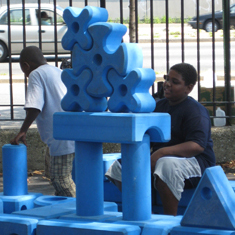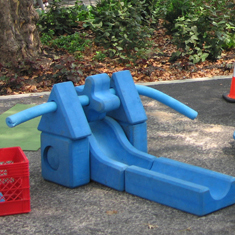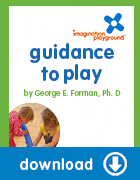Above, children understand that one gear can turn another if the two gears are positioned correctly and the axles are strongly fixed in place.
This is not an easy structure to figure out.

Children interlock a set of gears and place them on top of a structure as an ornamental top. The gears do not rotate but they do represent the way blocks can grip each other.

With some adjustments, water poured down the chute might turn this gear, giving children experience with how a liquid current can transfer motion to the solid gear.
What It Means
The two types of gears in the Imagination Playground Classic Block set afford rather different problems to solve. The Plus Gear and Clover Gear interlock and entice the children to make a giant jigsaw puzzle or tight- fitting wall as you see in the top photo. However, these two gears are not well matched for one turning the other on adjacent axles. If children were to make a row of gears, they might be intrigued by the way the first, third and fifth gear in the row turn in the same direction while turning in a direction opposite to the second and fourth. When children use the gear as a water wheel, they read the gear as “water catcher” instead of a “gear turner.”
2-4 Year Olds
At two or three years, children will be more attracted to the hole in the gears. They will put it on their hand, augmenting their own body, like a huge bracelet. Once they have explored the hole they may try to roll the gear on the ground.
4-7 Year Olds
Eventually the children will read the gear as something designed to be turned on an axle by an outside force, such as one’s hand, the wind, or the water. Then comes the idea of relating gears to each other. The first form of gear-to-gear play could be to make stationary walls or puzzles, but this requires mixing two different gear types, and children might prefer to play with just one type at a time.
7-10 Year Olds
Finally, the children will discover how one gear can move the other. As mentioned, the gear-turning structure has complicated construction requirements for making the gears both interface and turn.
This material is adapted from the publication “Imagination Playground’s Guidance to Play” by George E. Forman, PhD, Emeritus Professor, University of Massachusetts (Amherst) and President of Videatives, Inc.
Dr. Forman has over 33 years of experience in university teaching, cognitive research, multimedia design and educational consulting in the area of early childhood learning and development.
“Guidance to Play” covers 20 topics that help illustrate the significance in what children are doing as they play as well as concrete actions Play Associates can take to facilitate positive behaviors.



